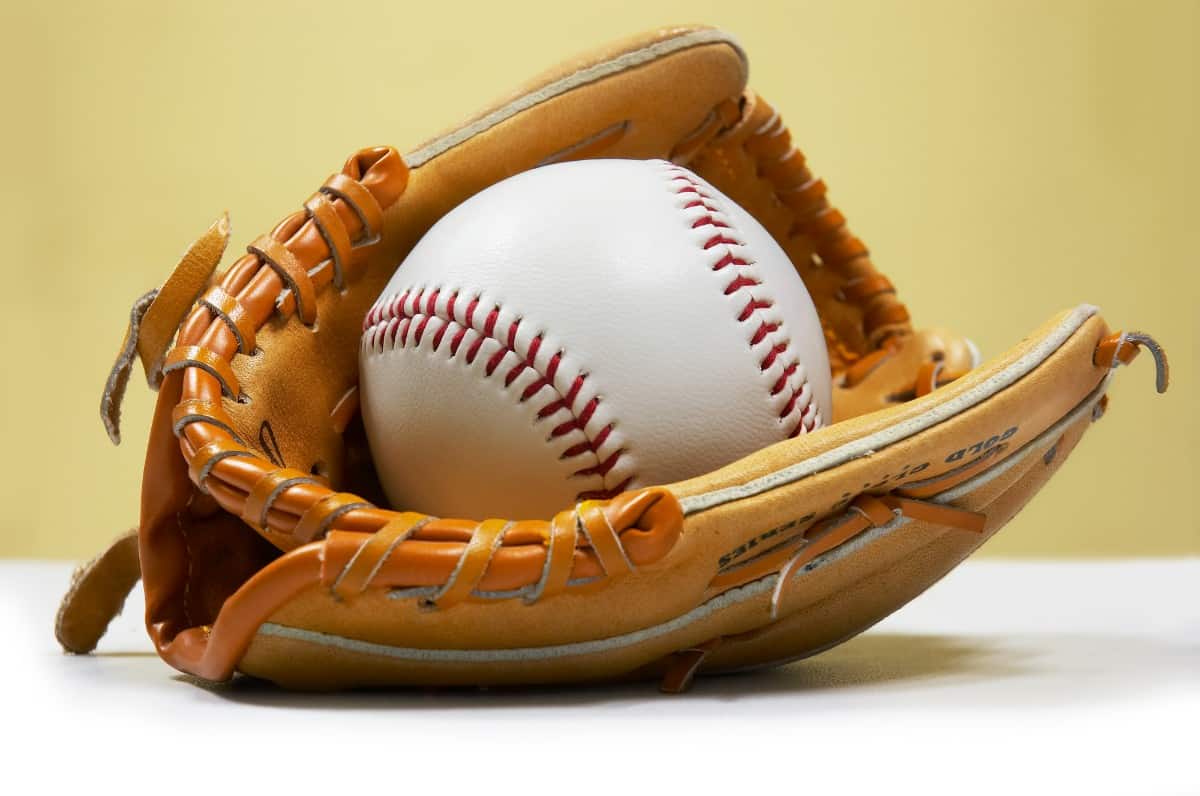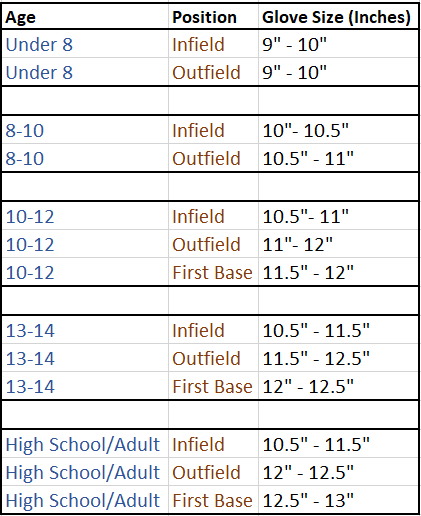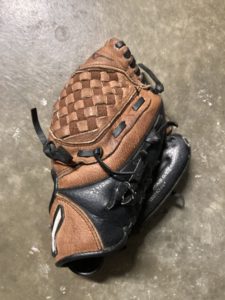It can be overwhelming trying to buy your kid a new glove. You want to make sure you’re getting a quality glove but one that fits. Our Baseball Glove Size Chart by Age will help you narrow your search and find the perfect Glove.
One of the main goals for a child learning baseball is learning how to catch. Finding the right baseball glove size will help them learn how to catch and bring them lots of confidence.
A quality glove, with just a few more dollars spent, is well worth it. A more quality and a bit pricier baseball glove will provide years of use. Whereas a cheaper glove might not last a season and is at risk of breaking. The baseball glove size chart above is a great guideline to help you find the perfect glove size
That said, don’t break the bank on a glove for a newcomer to baseball. If your child is under 8 years old, I don’t recommend spending a lot of money on a glove. Not the cheapest glove, but not the most expensive either, but somewhere in the middle.
The number one thing to do when buying your child or yourself a baseball glove is to get one that fits! A glove that’s too small will be difficult for a kid to learn how to catch and field. A glove that’s too big will alter their learning of how to squeeze their hand in a glove. With a glove size that’s too big, it stunts growth on learning the ability to catch and field a ball.
If anything, lean towards a smaller glove the younger they are because the feel of the glove feels like their hand. A youth baseball glove size that is too big is almost impossible for a small hand to squeeze.
So, the younger the player, the smaller the glove. Your child’s hands will grow rapidly, so again, do not spend a lot of money on their first glove.
This article will help you find the perfect glove size for your child, or even yourself.
Contents
Baseball Glove Sizing Chart Info
The best baseball glove size for anyone is one that fits. It should feel comfortable and an extension of the arm. Not one that feels heavy and hard to squeeze. Get a glove made of quality material, i.e., Leather. It also helps if the glove has new technology. These include flexibility, large webbing, big pocket, and soft leather.
The best thing to do is take your child somewhere that sells gloves and have them try them on. Have them squeeze the glove and make sure their hand fits in comfortably. Hold it high as if they’re catching a fly ball, and down on the ground like a grounder. Maybe practice with a baseball too in store to see how it feels. Don’t just buy any glove online without ever having your kid try it on. The best glove is the one that feels the most comfortable. It doesn’t have to be expensive, but make sure it’s also not cheap. You will be able to tell the difference. Try and pick one in between, especially if your child is still learning how to use baseball gloves.
Positions shouldn’t matter at all for ages under 10 when deciding on an infield glove or outfield glove. I firmly believe that players under 10 should try and learn multiple positions and at most have two gloves. One baseball glove is enough though, especially if you pick the perfect size. That way they can use it at multiple positions (besides catcher). A First Base Glove isn’t necessary under 10 years old either.
How do I know what size baseball glove my child needs?
Typically, most children under 10 can wear a baseball glove that is 10 to 11 inches. This would give them the most versatility to use in both the infield and outfield. A baseball glove of this size also isn’t too big or too small as they learn to use a glove.
As you can see, you don’t need to get very technical about a quarter to a half inch by position. Realistically, you can get a glove at 10 inches when your child is under 8 years old and if it holds up, they can use that all the way up until they are 10 years old.
Having purchased multiple gloves in my lifetime, the best thing to do is have your child or you try one on! Use the Baseball Glove Size Chart by Age to help you narrow your search.
Additional Baseball Glove Sizing Tips
-
Try on baseball gloves before purchasing
-
Squeeze Glove multiple times to see if you can fully close it
-
Does the baseball glove feel too heavy?
-
Catch a baseball with it. Does it easily catch or do you have to squeeze the baseball glove really hard?
-
Does the glove feel like it’s good quality? Is it durable?
Consider the position
One other critical factor to consider when buying a youth baseball glove or an adult baseball glove is to think about the position you intend to play. Most players only play 1-2 positions on a baseball team. So if you want to play an outfield position you will want to buy an outfield glove. If you are a pitcher and also play infield, you can likely use the same glove for each position. First base and catcher have their own unique glove so if you play one of these positions you will likely carry two gloves.
Baseball and Softball Gloves
If you are in the market for softball gloves, the same concept applies as mentioned above when looking for a baseball glove. Softball gloves typically have a much bigger webbing because the softball has a much bigger radius than a baseball.
Can you use a baseball glove for softball or vice versa?
Yes, it is possible to use a baseball glove for softball or a softball glove for baseball, but I would only suggest that if you are in a bind with no other glove option available. Baseball gloves are made as infield gloves and outfield gloves, and a softball would not fit comfortably in most infield gloves and would barely fit in outfield gloves.
How do you measure a child for a baseball glove?
The baseball glove size chart above is a great resource to help find the right baseball glove. As suggested, this is just meant to serve as a guide to lead you in the right direction. Because most young players are growing so quickly it is best to find the best youth baseball glove size for their age in life.
Baseball Glove Size Chart by Age Conclusion
I can’t stress enough how important it is to have your child try on a baseball glove before buying. Practice catching a ball and moving their hand around before buying. Checking how well it fits and how easy it is to squeeze is critical in finding the perfect glove size. How heavy or light it is. If the baseball glove is comfortable and your child likes how it feels, it should be good.
If you don’t have a physical place to go to try on gloves, that’s okay too. We are here to help you by narrowing your search based on your child’s age. Our Baseball Glove Size Chart by Age will help you find the right size glove from the start of your child’s baseball career until adulthood.






